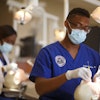Affirmative action is an umbrella that covers many activities — from aggressive recruiting to filling quotas, from the awarding of contracts to higher education admissions. This means that opponents can call up unpopular images of the most aggressive examples of affirmative action (such as hiring set-asides) to attack the entire idea of affirmative action.
In the higher education arena, opponents subtly “play the race card.” They focus on affirmative action related to the admission of racial/ethnic minorities although women, athletes, and children of alumni and large donors also receive special consideration.
An initial (and critical) question is: What is society’s compelling interest in assuring racial and ethnic diversity in medicine? The rationale for racial and ethnic diversity in medicine is robust, including at least five components. * It is a matter of simple equity and justice that minorities have equal opportunities to be a part of such a key profession in our society.
We now have data that minority physicians improve access to care. They are much more likely to serve minority patients, poorer patients, and sicker patients.
A broad research agenda is essential for scientific progress against the diseases that plague and kill all Americans. Though there is less data to support this assertion, in my experience people research the problems they see and feel. in running faculty development programs, minority physicians are much more likely to be interested in research problems that are relevant to poor and minority patients.
Medicine is now a trillion dollar-a-year corporate enterprise. For a variety of reasons that are now well accepted in corporate America, it is essential that some of those managers be minority.
“Cultural competence” is an essential skill in serving the diverse patient population,s that characterize America now. This requires diverse teams of students who can teach each other cultural competence and diverse health care delivery teams to practice it.
We have made dramatic progress in making medicine “look like America.” Only 30 years ago, 99 percent of students in American medical schools (excluding Howard and Meharry) were non-Hispanic whites. As with other parts of our society, in the late 1960s medical schools opened their doors and minority matriculants rapidly increased in the mid 1970s to about 8 percent, where it stalled for 15 years.
In the late 1980s the Association of American Medical Colleges (which represents all 125 of the nation’s medical schools and about 400 of our major teaching hospitals) began to organize a new program to dramatically increase minority enrollment, later named Project 3000 by 2000. The Project takes its name from its ambitious goal to reach AAMC’s longstanding target of population parity for underrepresented minorities. Enrolling 3,000 minorities out of the approximately 16,000 annual matriculants to U.S. medical schools by the year 2000 would bring us close to the proportion of underrepresented minorities in the population-at-large.
Since 1990, minority enrollment in medical schools has soared 37 percent, largely because of increases in the overall pool of applicants to medical schools combined with the energizing effects of Project 3000 by 2000. Sadly, however, among African-American men, trends are going in the wrong direction. In 1971, 626 Black men matriculated to American medical schools. That number has not been equaled since. In fact, Blacks are the only racial/ethnic group in which women medical students outnumber men.
Project 3000 by 2000 will not show its true impact for many years. While the Project, and the many other academic reform projects launched in the United States, are the long-term approach to achieving diversity in medical schools, affirmative action is an essential tool in the near term.
One of the arguments against affirmative action is that it allows the admission (or hiring) of “unqualified” people. Of the 1,844 underrepresented minorities who entered medical schools in the United States in 1992, 95 percent are still enrolled, and only one percent have been dismissed.
The AAMC feels so strongly about the necessity of affirmative action that we have begun organizing a national coalition — “Health Professionals for Diversity” — which will attempt to communicate to opinion leaders in America that affirmative action is indispensable for all of the health professions, not just medicine, if we are to prepare the health work force for the 21st century.
COPYRIGHT 1996 Cox, Matthews & Associates
© Copyright 2005 by DiverseEducation.com















